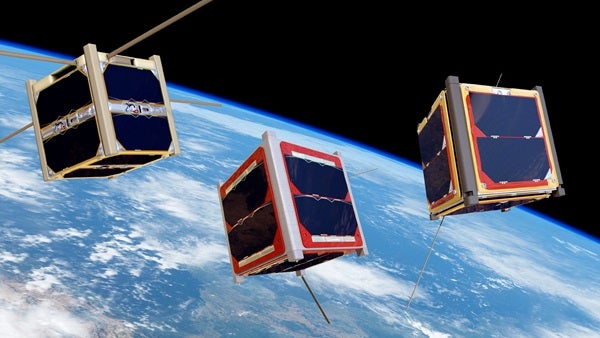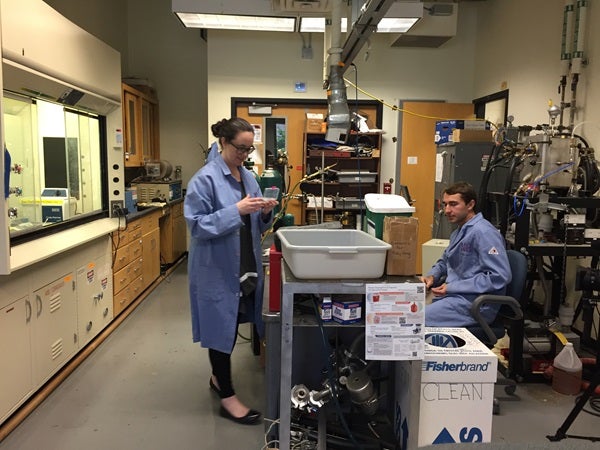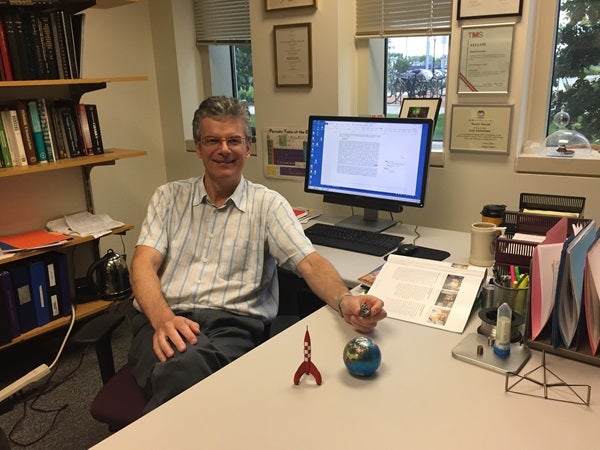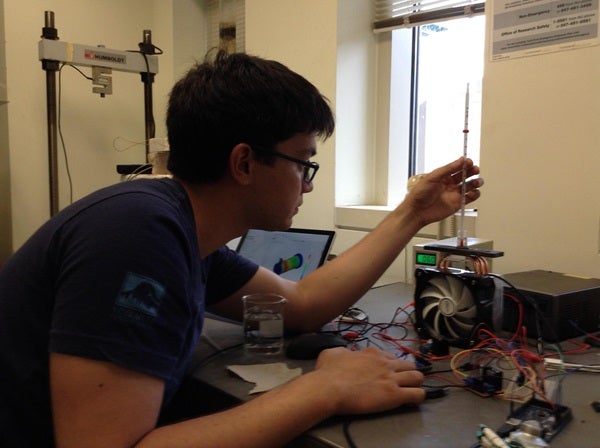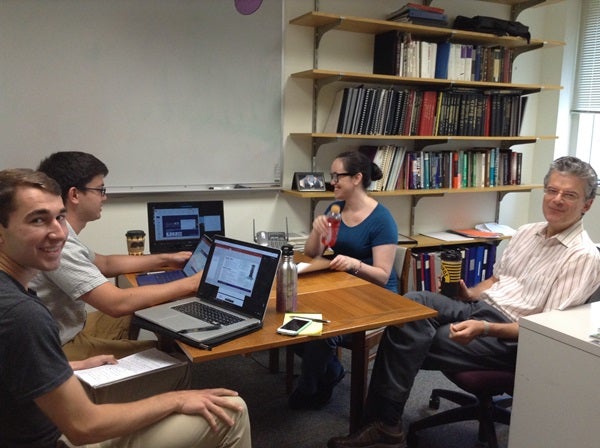Given that it takes nearly 300 days to reach Mars from Earth, imagine the time, the number of trips, the weight of materials to be carried and the cost to sustain even a small community. Could a better alternative be to figure out how to grow food, build houses or make fuel cells on Mars, à la Matt Damon in The Martian?
An undergraduate research team at Northwestern University (NU) is tackling the challenge of space-based manufacturing. Meet SpaceICE: a collaborative research endeavor under the guidance of Professor David Dunand of Northwestern’s Department of Material Sciences. The undergraduates plan to test a pioneering manufacturing process on a satellite they’re currently assembling in conjunction with a team at University of Illinois Urbana-Champaign (UIUC). The mission will launch on a NASA CubeSat, a small cubic satellite, in 2018.
The SpaceICE instrumentation onboard, designed and built in the Materials Science Department at Northwestern University, will take an established materials fabrication approach called freeze-casting and test how the method works in near-Earth orbit. “The CubeSat is going to carry an experiment to freeze-cast silver coated glass beads,” says Krysti Scotti, the undergraduate spearheading the project, who also put together the SpaceICE student team. That team is now racing to assemble the freeze–caster and related CubeSat instrumentation in time to deliver the payload to UIUC by the beginning of next year. The UIUC team members will integrate the instruments into a CubeSat envelope and enable communication using a ground station set up to receive data from the satellite by mid-2018, before handing the entire package to NASA for an October 1, 2018, launch.
The freeze-casting process begins with a suspension of water and particles — titanium oxide, for example. This suspension is frozen from the bottom up, which causes ice crystals to grow upwards, pushing the particles out of the way in the process. These particles (the titanium oxide, in our example) are compressed and eventually form a solid material. The ice is then vaporized off and the fragile remains are baked to bind them together by heat to form a microscopically porous new material, which scientists refer to as a foam.
Just to underscore the point — the new material was manufactured using water. Simple, non-toxic and recyclable. And this is the experiment that Scotti and her team will test out in the CubeSat in a microgravity environment.
“Freeze-casting is a unique technique which differentiates itself from other manufacturing methods like 3D printing, in that it is cheap and scalable,” says Dunand. Sylvain Deville, a material science expert at the French National Centre for Scientific Research in Paris, adds, “the required equipment is a lot more simple, for sure, as you don’t need much apart from a mold and a cold source.
Typically, CubeSats are tiny satellites, weighing up to 3 pounds (just over 1 kilogram), which are used to collect information about climate and weather, or to image Earth. CubeSats may look deceptively small, but they can perform a wide variety of space science.
“Something unique with CubeSats is that it is inexpensive enough that you can build two or three. They can communicate and triangulate together and we can get space imagery like never before. It is a game changer for science,” says Brenda Dingwall, NASA’s mission manager for SpaceICE, whose duties include ensuring everything is shipshape before the launch. After all, CubeSats are a tremendous investment on NASA’s part, she adds.
But the constraints and challenges of launching a CubeSat with a working experiment make SpaceICE an expensive affair. “That is why with any NASA-funded project we have several milestone reviews before we even start building,” says Scotti, who along with her SpaceICE team members geared up for a critical design review (CDR) meeting with NASA’s mission manager and engineers during the first week of August. The weeks leading up to the CDR were fraught with anxiety and excitement — and a lot of experiments!
Freeze-casting is a complicated process involving multiple parameters to consider. One of these parameters is gravity. For freeze-casting to be a viable alternative to competing technologies such as 3D printing in space, Dunand must show how gravity affects the formation of these materials. If there were a way to magically switch off gravity and study freeze-casting, it would allow the researchers to get a better handle on the freezing process. Thus, scientists plan to use space as a lab to better understand the nuts and bolts of the freeze-casting process on terra firma. “Once we crack this in space, we will be comparing the very same experiment that we put in CubeSat under zero gravity versus full gravity here in the good old State of Illinois,” laughs Dunand.
The SpaceICE team replicated the experiment in near zero-gravity environment on NASA’s C-9 parabolic flights. These flights are designed to generate 30 seconds of microgravity. And that gave SpaceICE exactly half a minute to test freeze-casting. “Typically such flights have 50 parabolas. You get a lot of samples, but you have to freeze very fast,” says Scotti. With the CubeSat, they’ll get streams of data continuously for six months, allowing for much slower freezing.
“For parabolic flights, we are on an air-filled plane where there’s no worry of materials degrading. Whereas we do worry for CubeSat as most plastics and glass used in our ‘on Earth’ experiments degrade due to vacuum (conditions in space),” says Scotti. Even something as simple as a camera lens, required to take pictures of the freeze-casting process as water outgasses slowly in space, must be rated to withstand harsh conditions. The alternative is a blind experiment with no equipment to visualize the freeze-casting process in space. So, add special camera lenses to the bill.
Yet another parameter to “vacuum- proof” was the sample container — a two-inch-high cylinder that will contain the actual freeze-casting experiment. Designing the container was one of SpaceICE’s biggest challenges to date. This container needs to account for the expansion of ice during the experiment’s repetitive freeze and thaw cycles. It must also survive launch and remain leak-free and transparent for months in space. This challenge was solved in nine months, thanks to the capable hands of design engineer Andy McIntosh, a senior at NU. “We managed to figure out that the sample container needed to be made out of Pyrex to fit all the design requirements,” says Scotti.
McIntosh’s other challenges included ensuring the container, which is rigged with several hair-thin wires to take temperature readings throughout the experiment, won’t shatter upon launch into space. At the time of the launch, the gravity felt by the container is nearly 8 to 12 times the gravitational force of Earth; a single nick to these wires and the CubeSat would be reduced to yet another piece of space junk even before it reaches its orbit.
The green light
The results of these tests — carried over the past year by Scotti, McIntosh and other undergrads at NU and UIUC — were presented in a recent critical design review to convince NASA that the team had thought through every eventuality to ensure a successful launch.
And all this hard work paid off. “Superb job,” said a highly impressed Dingwall at the end of the CDR. “You guys and especially the students should give yourself a pat on your backs.” SpaceICE breathed a huge sigh of relief having secured the go-ahead to build the CubeSat.
Now, these undergraduates are leading the way. Dunand envisions going to Mars some day and manufacturing materials. “I would literally take Mars dirt, freeze-cast it, then reduce it with hydrogen to create an iron-porous structure for structural applications, for habitat, or maybe for transport or for in-situ utilization; in fact, we are doing just this right now in the lab” Dunand says excitedly.
Freeze-casting might just be the answer to firmly imprinting human footsteps on such unchartered territories, along with providing the building blocks to make these alien places habitable.
Lakshmi Chandrasekaran covered the SpaceICE team as an embedded reporter. She found it fascinating to witness such a unique endeavor by SpaceICE and provides us with an insider’s view of cutting edge material sciences and a snapshot of the preparations leading up to the launch.

